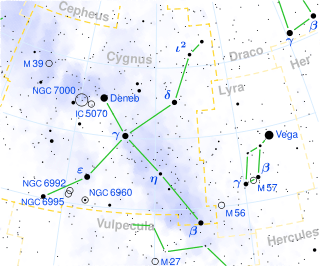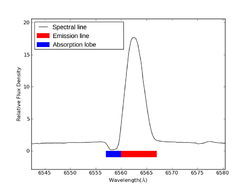P Cygni
P Cygni (34 Cyg) is a variable star in the constellation Cygnus. The designation "P" was originally assigned by Johann Bayer in Uranometria as a nova. Located about 5,000 to 6,000 light-years (1,500–1,800 parsecs) from Earth, it is a hypergiant luminous blue variable (LBV) star of spectral type B1Ia+ that is one of the most luminous stars in the Milky Way.
 | |
| Observation data Epoch J2000 Equinox J2000 | |
|---|---|
| Constellation | Cygnus |
| Right ascension | 20h 17m 47.2018s[1] |
| Declination | +38° 01′ 58.549″[1] |
| Apparent magnitude (V) | 4.82[2] (3 to 6[3]) |
| Characteristics | |
| Spectral type | B1Ia+[4] |
| U−B color index | -0.58[4] |
| B−V color index | +0.42[4] |
| Variable type | LBV[3] |
| Astrometry | |
| Radial velocity (Rv) | -8.9[5] km/s |
| Proper motion (μ) | RA: -3.53[1] mas/yr Dec.: -6.88[1] mas/yr |
| Parallax (π) | 0.32 ± 0.16[1] mas |
| Distance | 1,700[6] pc |
| Absolute magnitude (MV) | −7.9[7] |
| Details | |
| Mass | 30[8] M☉ |
| Radius | 76[9] R☉ |
| Luminosity | 610,000[9] L☉ |
| Surface gravity (log g) | 1.2[6] cgs |
| Temperature | 18,700[9] K |
| Metallicity | 0.29[9] He/H |
| Rotational velocity (v sin i) | 35[6] km/s |
| Other designations | |
Nova Cyg 1600, 34 Cyg, JP11 3218, TD1 26474, GSC 03151-03442, TYC 3151-3442-1, AG+37° 1953, 2MASS J20174719+3801585, ALS 11097, HD 193237, MCW 849, BD+37°3871, Hen 3-1871, PLX 4837, CEL 5017, PPM 84645, P Cyg, RAFGL 5493S, GC 28218, HIP 100044, ROT 2959, GCRV 12673, HR 7763, SAO 69773, AAVSO 2014+37A | |
| Database references | |
| SIMBAD | data |
Visibility
The star is located about 5,000 to 6,000 light-years (1,500–1,800 parsecs) from Earth. Despite this vast distance, it is visible to the naked eye in suitable dark sky locations. It was unknown until the end of the 16th century, when it suddenly brightened to 3rd magnitude. It was first observed on 18 August (Gregorian) 1600 by Willem Janszoon Blaeu, a Dutch astronomer, mathematician and globe-maker. Bayer's atlas of 1603 assigned it the miscellaneous label P and the name has stuck ever since. After six years the star faded slowly, dropping below naked-eye visibility in 1626. It brightened again in 1655, but had faded by 1662. Another outburst took place in 1665; this was followed by numerous fluctuations. Since 1715 P Cygni has been a fifth magnitude star, with only minor fluctuations in brightness. Today it has a magnitude of 4.8, irregularly variable by a few hundredths of a magnitude on a scale of days.[8] The visual brightness is increasing by about 0.15 magnitude per century, attributed to a slow decrease in temperature at constant luminosity.[10]
P Cygni has been called a "permanent nova" because of spectral similarities and the obvious outflow of material, and was once treated with novae as an eruptive variable; however, its behaviour is no longer thought to involve the same processes associated with true novae.[11]
Luminous blue variable
P Cygni is widely considered to be the earliest known example of a luminous blue variable. However, it is far from a typical example. Typically, LBVs change in brightness with a period of years to decades, occasionally hosting outbursts where the brightness of the star increases dramatically. P Cygni has been largely unvarying both in brightness and spectrum since a series of large outbursts in the 17th century. Similar events have been seen in Eta Carinae and possibly a handful of extra-galactic objects.[12]
P Cygni does show evidence for previous large eruptions around 900, 2,100, and possibly 20,000 years ago. In more recent centuries, it has been very slowly increasing in visual magnitude and decreasing in temperature, which has been interpreted as the expected evolutionary trend of a massive star towards a red supergiant stage.[12]
Evolution
Luminous blue variables like P Cygni are very rare and short lived, and only form in regions of galaxies where intense star formation is happening. LBV stars are so massive and energetic (typically 50 times the mass of the Sun and tens of thousands of times more luminous) that they exhaust their nuclear fuel very quickly. After shining for only a few million years (compared to several billion years for the Sun) they erupt in a supernova. The recent supernova SN 2006gy was likely the end of an LBV star similar to P Cygni but located in a distant galaxy.[13] P Cygni is thought to be in the hydrogen shell burning phase immediately after leaving the main sequence.[12]
It has been identified as a possible type IIb supernova candidate in modelling of the fate of stars 20 to 25 times the mass of the Sun (with LBV status as the predicted final stage beforehand).[14]
P Cygni profile

P Cygni gives its name to a type of spectroscopic feature called a P Cygni profile, where the presence of both absorption and emission in the profile of the same spectral line indicates the existence of a gaseous envelope expanding away from the star. The emission line arises from a dense stellar wind near to the star, while the blueshifted absorption lobe is created where the radiation passes through circumstellar material rapidly expanding in the direction of the observer. These profiles are useful in the study of stellar winds in many types of stars. They are often cited as an indicator of a luminous blue variable star, although they also occur in other types of star.[12][15]
The size of the stellar wind H-alpha emission region is 5.64±0.21 milli-arcseconds.[8] At the estimated distance of 1,700 parsecs this is a physical size of approximately 26 stellar radii.
Companion
It has been proposed P Cygni's eruptions could be caused by mass transfer to a hypothetical companion star of spectral type B that would have a mass between 3 and 6 times the mass of the Sun and would orbit P Cygni each 7 years in a high eccentricity orbit. Infall of matter into the secondary star would produce the release of gravitational energy, part of which would cause an increase of the luminosity of the system.[16]
References
- Van Leeuwen, F. (2007). "Validation of the new Hipparcos reduction". Astronomy and Astrophysics. 474 (2): 653–664. arXiv:0708.1752. Bibcode:2007A&A...474..653V. doi:10.1051/0004-6361:20078357.
- Ducati, J. R. (2002). "VizieR On-line Data Catalog: Catalogue of Stellar Photometry in Johnson's 11-color system". CDS/ADC Collection of Electronic Catalogues. 2237: 0. Bibcode:2002yCat.2237....0D.
- Samus, N. N.; Durlevich, O. V.; et al. (2004). "VizieR Online Data Catalog: Combined General Catalogue of Variable Stars (Samus+ 2004)". VizieR On-line Data Catalog: II/250. Originally Published in: 2004yCat.2250....0S. 2250: 0. Bibcode:2004yCat.2250....0S.
- Smith, L. J.; Crowther, P. A.; Prinja, R. K. (1994). "A study of the luminous blue variable candidate He 3-519 and its surrounding nebula". Astronomy and Astrophysics. 281: 833. Bibcode:1994A&A...281..833S.
- Gontcharov, G. A. (2006). "Pulkovo Compilation of Radial Velocities for 35 495 Hipparcos stars in a common system". Astronomy Letters. 32 (11): 759–771. arXiv:1606.08053. Bibcode:2006AstL...32..759G. doi:10.1134/S1063773706110065.
- Najarro, F.; Hillier, D. J.; Stahl, O. (1997). "A spectroscopic investigation of P Cygni. I. H and HeI lines". Astronomy and Astrophysics. 326: 1117. Bibcode:1997A&A...326.1117N.
- Van Genderen, A. M. (2001). "S Doradus variables in the Galaxy and the Magellanic Clouds". Astronomy and Astrophysics. 366 (2): 508–531. Bibcode:2001A&A...366..508V. doi:10.1051/0004-6361:20000022.
- Balan, Aurelian; Tycner, C.; Zavala, R. T.; Benson, J. A.; Hutter, D. J.; Templeton, M. (2010). "THE SPATIALLY RESOLVED Hα-EMITTING WIND STRUCTURE OF P CYGNI". The Astronomical Journal. 139 (6): 2269. arXiv:1004.0376. Bibcode:2010AJ....139.2269B. doi:10.1088/0004-6256/139/6/2269.
- Najarro, F. (2001). "Spectroscopy of P Cygni". P Cygni 2000: 400 Years of Progress. 233: 133. Bibcode:2001ASPC..233..133N.
- Lamers, H. J. G. L. M.; De Groot, M. J. H. (1992). "Observed evolutionary changes in the visual magnitude of the luminous blue variable P Cygni". Astronomy and Astrophysics. 257: 153. Bibcode:1992A&A...257..153L.
- Szkody, P. (1977). "Infrared photometry of dwarf novae and possibly related objects". The Astrophysical Journal. 217: 140. Bibcode:1977ApJ...217..140S. doi:10.1086/155563.
- Israelian, G.; De Groot, M. (1999). "P Cygni: An Extraordinary Luminous Blue Variable". Space Science Reviews. 90 (3/4): 493. arXiv:astro-ph/9908309v1. Bibcode:1999SSRv...90..493I. doi:10.1023/A:1005223314464.
- Smith, Nathan; Li, Weidong; Foley, Ryan J.; Wheeler, J. Craig; Pooley, David; Chornock, Ryan; Filippenko, Alexei V.; Silverman, Jeffrey M.; Quimby, Robert; Bloom, Joshua S.; Hansen, Charles (2007). "SN 2006gy: Discovery of the Most Luminous Supernova Ever Recorded, Powered by the Death of an Extremely Massive Star like η Carinae". The Astrophysical Journal. 666 (2): 1116–1128. arXiv:astro-ph/0612617. Bibcode:2007ApJ...666.1116S. doi:10.1086/519949.
- Groh, J. H.; Meynet, G.; Ekström, S. (2013). "Massive star evolution: luminous blue variables as unexpected supernova progenitors". Astronomy & Astrophysics. 550: 4. arXiv:1301.1519. Bibcode:2013A&A...550L...7G. doi:10.1051/0004-6361/201220741. L7.
- Robinson, Keith (2007). "The P Cygni Profile and Friends". Spectroscopy: The Key to the Stars. Patrick Moore's Practical Astronomy Series. pp. 119–125. doi:10.1007/978-0-387-68288-4_10. ISBN 978-0-387-36786-6.
- Kashi, Amit (2010). "An indication for the binarity of P Cygni from its 17th century eruption". Monthly Notices of the Royal Astronomical Society. 405 (3): 1924. arXiv:0912.3998. Bibcode:2010MNRAS.405.1924K. doi:10.1111/j.1365-2966.2010.16582.x.